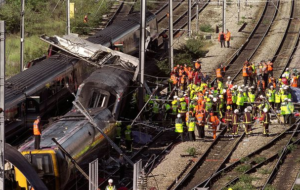On the morning of 5 October 1999, two trains travelling at a combined speed of 130mph collided and crashed into each other, causing the death of 31 passengers at Ladbroke Grove, London.

32 candles were lit for each of the passengers that tragically died, and one more for those that survived the crash, followed by a minute silence, to mark 20 years since the tragedy on 5 October 2019.
Cressida Dick, Metropolitan Police Commissioner, attended the memorial as well as representatives from London Ambulance Service and London Fire Brigade.
The Thames Train service travelling from Paddington had gone through a red signal and crashed into a First Great Western train. 417 people were injured, and one carriage exploded into a fireball.
Michael Hodder, driver for the Thames Train and Brian Cooper, driver for the First Great Western, were both killed in the crash.
The Ladbroke Grove Rail Inquiry written by Lord Cullen and published by the Health and Safety Executive, scrutinised Railtrack, which was the company responsible for maintaining British railway now taken over by Network Rails, for numerous safety breeches including:
- Not providing adequate driver training and
- Questioned the response time of signallers, in Slough control box, in acting quicker to warn drivers of crash.
Five years before the horrific collision, drivers misinterpreted signals at least seven times and Railtrack were warned about it but, no adequate action was taken by the company according to Blackfriars Crown Court.
Consequently, Railtrack was liable for a “catalogue of failures” that led to the tragic accident.
Phil Chambers BSc, CMIOSH Strategic Safety Systems Ltd, applied the Paddington Rail Crash as a case study to the Heinrich’s Triangle, which shows that if you have enough safety breaches, it will eventually lead to a serious injury.
Lord Cullen described Thames Train’s safety culture as “less than adequate”. It was reported that the crash could have been prevented had there been a train protection in place.
Jonathan Duckworth, Chairman of the Paddington Survivors’ Group and a survivor of the tragic crash expressed: “Our crash and others happened because they took their eyes off safety. If they do that again more will be killed and more lives devastated.”
Since the crash, there has been a spotlight on safety on British rails, but criticisms are still high, according to the Office of Rail and Road, after five years of improvement, minor accidents have increased, three rail workers have been killed by trains in the last year and a total of 41 trains passed through red signals in July 2019, as noted by The Rail Safety and Standards Board, which was created in the aftermath of the Paddington Rail Crash.
SHP



















